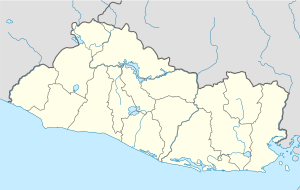San Isidro, Cabañas
| San Isidro | |
|---|---|
| Municipality | |
| Location in El Salvador | |
| Coordinates: 13°50′N 88°43′W / 13.833°N 88.717°WCoordinates: 13°50′N 88°43′W / 13.833°N 88.717°W | |
| Country |
|
| Department | Cabañas Department |
| Area | |
| • Total | 30.24 sq mi (78.33 km2) |
| Elevation | 1,191 ft (363 m) |
| Population (2006) | |
| • Total | 10,533 |
San Isidro is a municipality in the Cabañas department of El Salvador, roughly 70 kilometres (43 mi) northeast of San Salvador.
The parish of San Isidro was established in an electoral law dated February 18, 1873. It belonged to the San Vicente Department from the 12 June 1824 to 10 February 1873, after which it became part of the newly formed Cabañas Department. By legislative decree of February 7, 1879 it was awarded municipal status.
In 1977, archaeologist Wolfgang Haberland was involved in an excavation in the municipality. He discovered petroglyphs in the Grutas de Corinto dated to the Preclassic Mesoamerican period ( 1200 to 400 BC). In the late 1990s, the FAO funded the "Sustainable agriculture on hillsides" project in the municipality of San Isidro.
The municipality covers an area of 78.33 square kilometres (30.24 sq mi), and is bordered to the north and east by Sensuntepeque, to the east by Guacotecti, to the south by Santa Clara, San Esteban Catarina and San Sebastián in the San Vicente Department, and to the west by Ilobasco. It is surrounded by the Morontepeque, Humeras and El Orégano hills, and the principal rivers are the Las Cañas, De los Pueblos, Titihuapa, San Isidro, El Jícaro and Viejo.
The municipality is divided into 7 cantons, with 22 caseríos (hamlets):
The principal agricultural items produced include basic grains, sesame and sugarcane. The people raise livestock: cattle, pigs, horses and mules. Dairy products and sweet brown sugar are produced. San Isidro is also a manufacturer of building materials. The Asociacion de Amigos de San Isidro Cabanas (ASIC, Friends of San Isidro Cabanas Association) is a community organization which deals with local mining.
...
Wikipedia

